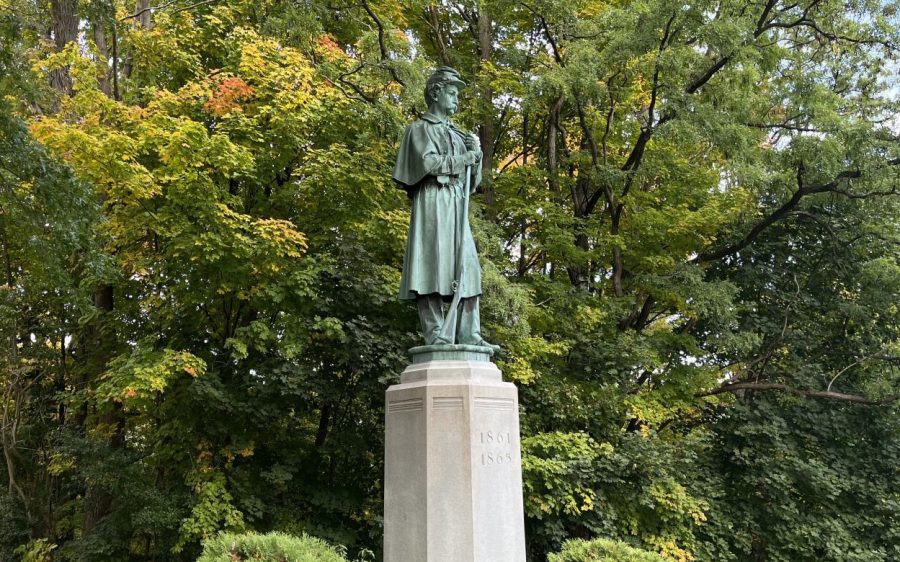Confederate graffiti found on Soldiers Monument
October 12, 2022

On Sunday morning, a local resident reported racist graffiti on the Soldiers Monument outside Griffin Hall to Campus Safety Services (CSS), President Maud S. Mandel wrote in a campus-wide email on Monday which alerted the College community to the bias incident.
“The pedestal of the Soldiers Monument in front of Griffin Hall had been defaced with graffiti of a Confederate flag and the word ‘Rebel,’ each about 6 inches high,” Mandel wrote in the email. “A Custodial staff member came to the site and removed as much of the graffiti as possible, then covered the remaining traces until Facilities colleagues could more thoroughly scrub the stone [on Monday].” The Soldiers Monument, built in 1868, commemorates students and alums of the College who fought for the Union in the Civil War.
“The Confederate flag and the word ‘Rebel’ are commonly used as symbols by white supremacists and other extremist factions,” Mandel wrote.
Mandel’s email also noted that CSS will alert the Williamstown Police Department (WPD) as it investigates the incident. “When a member of our campus community is affected in any way as a result of a crime, the CSS department will support WPD in any way we can within the policies of the College,” Director of CSS Eric Sullivan wrote in an email to the Record.
Sullivan said that CSS has handled previous potential bias incidents similarly — by notifying the Office of Institutional Diversity, Equity, and Inclusion (OIDEI) and, if a crime was committed, alerting the WPD, which then conducts its own investigation.
Sullivan also noted that CSS has reached out to College employees who held events in or near Griffin Hall during the weekend to ask if they saw any activity that might be related to the incident.
Last spring, the Record reported on three bias incidents at the College. On Jan. 4, a student tabling in Paresky Center to spread awareness about the Chinese Communist Party’s human rights violations against Uyghur Muslims returned from a break to find his two heirloom eagle statues missing and his Tibetan flag on the floor — all items that had been displayed on the table beforehand. Then, on Feb. 12, two students watched three young white men yell anti-Black slurs outside the First Congregational Church before entering the Paresky Center. They discarded a Black Lives Matter sign, which they had taken from the church, outside of Paresky and swore at the pair of students for following them into the student center. And, on Feb. 15, a College library employee found antisemitic and racist flyers in a section of Sawyer Library that contains books about German history from 1933 to 1945.
The Record editorialized on these incidents, calling for a public response and visible actions to support students from the College. “Even while some of these incidents’ perpetrators may not belong to the College community, they regardless leave students reeling from hurt, fear, and insecurity in what is supposed to be a safe space to learn and grow,” the editorial reads. “While the College does not control the hate responsible for this hurt, it can control its institutional response when such harm is inflicted.”
Vice President for Institutional Diversity, Equity, and Inclusion Leticia S.E. Haynes ’99 said OIDEI is always available to help students and that it partners with the Chaplains’ Office and Integrative Wellbeing Services (IWS) to provide resources and communal spaces to reflect in the wake of such incidents.
“Even though we don’t have all of the details, in the wake of this incident … OIDEI is committed to supporting students, faculty, and staff by holding space for reflection, and facilitating opportunities for members of the community to develop programming,” Haynes wrote in an email to the Record. “In the past, OIDEI has held reflection spaces at times when there are incidents of bias or discrimination or tragedy locally or nationally.”








